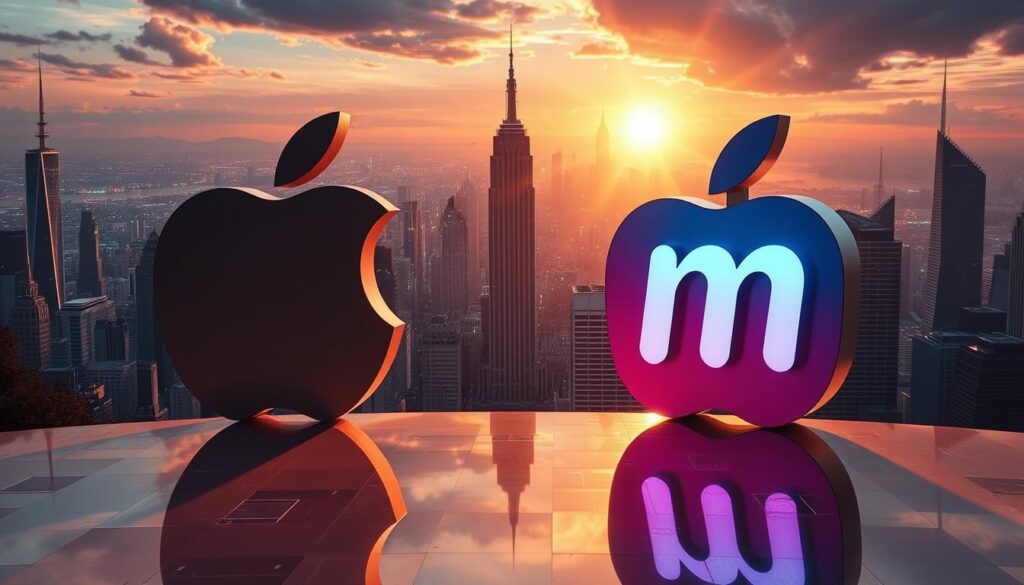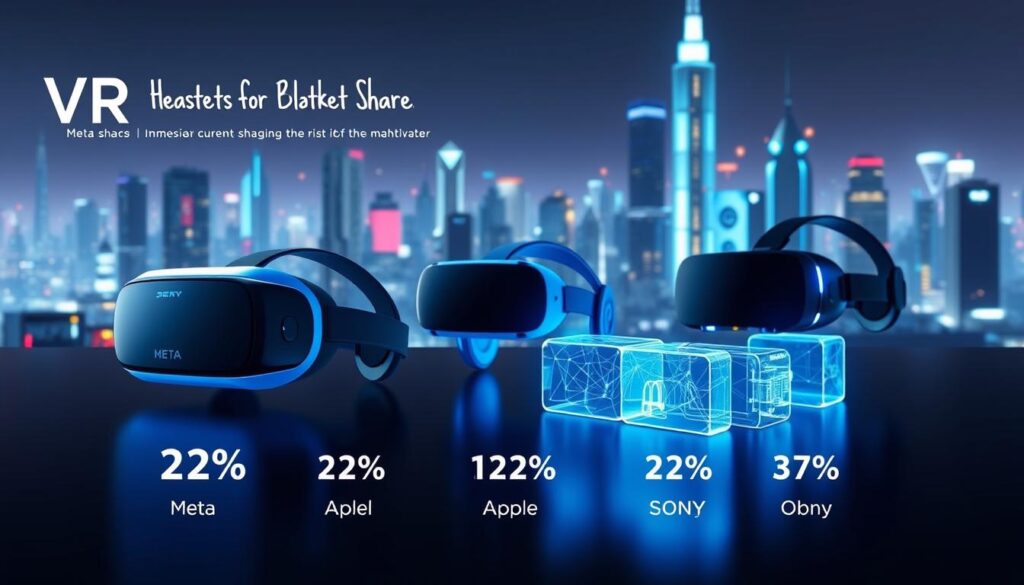
The race to control the digital frontier is heating up. Two tech giants are pouring resources into shaping the future of immersive experiences. With billions invested and contrasting strategies, 2025 could decide which company leads this transformative space.
One firm bets big on accessibility, selling millions of affordable VR headsets. The other focuses on premium hardware, targeting early adopters. Both face critical challenges—scaling adoption, refining AI integration, and proving their ecosystems offer lasting value.
Financial stakes are enormous. One company has lost billions funding its vision, while the other leverages a thriving services division. The coming year will test whether bold investments or calculated innovation wins in this high-stakes battle.
Key Takeaways
- Massive investments highlight the strategic importance of this emerging space
- Diverging approaches—affordable hardware versus premium ecosystem—create distinct markets
- 2025 will reveal which strategy gains mainstream traction
- Success depends on solving adoption barriers and delivering compelling use cases
- AI integration emerges as a critical differentiator for both companies
The Metaverse in 2025: A Battle of Titans
Two tech giants are redefining immersive experiences with contrasting strategies. One dominates the VR market with affordable *devices*, while the other targets high-end adopters with premium hardware. The gap in pricing reflects their divergent visions for the digital *world*.

Quest 3’s mass appeal is clear—3 million units sold at $499 each. Its success hinges on accessibility, making VR a mainstream *technology*. Meanwhile, the $3,499 Vision Pro positions itself as a “*spatial computing*” tool for professionals. The table below highlights key differences:
| Feature | Quest 3 | Vision Pro |
|---|---|---|
| Price | $499 | $3,499 |
| Focus | Social VR | Productivity |
| Ecosystem | Horizon Worlds | iOS (1B+ devices) |
| AI Integration | Avatars | ARKit (privacy-first) |
Meta’s mobile strategy could be a game-changer. Boz’s memo calls Horizon Worlds “critical for retention,” leveraging smartphones to bridge the *space* between casual and dedicated users. Apple, however, banks on its loyal customer base and seamless ecosystem.
“2025 determines if we’re visionaries or failed adventurers.”
The *numbers* tell a story of risk versus refinement. One company bets on *technology* adoption at scale, while the other prioritizes exclusivity. As 2025 approaches, their paths will reveal which *vision* resonates with users worldwide.
Current Market Positions: Who Holds the Edge?
Market dynamics reveal contrasting fortunes for these industry leaders. One dominates unit sales with affordable hardware, while the other leverages premium pricing and ecosystem strength. The gap in market share tells only part of the story.

Reality Labs: Betting Big on VR/AR
$60 billion in losses since 2020 might shock investors, but context matters. This equals Boeing’s entire commercial aircraft losses over six years. Yet parent company profits from social apps exceed $260 billion during the same period.
Quest 3’s sales numbers tell a success story—3 million units versus 200,000 for its premium competitor. With 70% market share in VR devices, the strategy of accessibility appears to be working. As one executive noted:
“We’re building the infrastructure for tomorrow’s digital experiences today—losses are investments in market creation.”
A Strategic Late Entry
The $3,499 headset targets professionals, not mass consumers. But with Services generating $26 billion quarterly—more than Nike and Coca-Cola combined—the company can afford patience. 1 billion active subscriptions provide a ready-made adoption network.
Brand loyalty remains the wild card. Early adopters pay premium prices for seamless ecosystem integration. This could accelerate adoption once prices drop, despite the late start in the VR space.
Technological Innovations Shaping the Future
Cutting-edge advancements are reshaping how we interact with digital environments. From AI-driven social interactions to privacy-centric designs, the race hinges on which technology delivers more compelling user value. Below, we dissect the core innovations defining this space.
Hyper-Realistic AI and Open Ecosystems
Meta’s LLaMA-powered avatars aim to revolutionize social VR. These AI models enable lifelike expressions and real-time language processing, blurring lines between virtual and physical interactions. The company’s open metaverse vision prioritizes cross-platform accessibility, though retention remains a hurdle.
Ray-Ban smart glasses serve as a testing ground for AR features like live translation. Unlike closed platforms, Meta bets on third-party developers to expand its ecosystem. However, critics question whether this approach can match the polish of walled gardens.
Privacy-First AR and Silicon Mastery
Apple’s strategy relies on on-device AI processing, ensuring user data never leaves the device. The Vision Pro’s M2/R1 chips leverage neural engines for spatial awareness, a stark contrast to cloud-dependent competitors. ARKit 2025 updates promise enhanced object recognition, targeting professional workflows.
| Feature | Meta’s Approach | Apple’s Approach |
|---|---|---|
| AI Processing | Cloud-based (LLaMA) | On-device (Neural Engine) |
| AR Hardware | Ray-Ban smart glasses | Vision Pro headset |
| Ecosystem | Open (Horizon Worlds) | Closed (iOS integration) |
| Focus | Social immersion | Productivity & privacy |
While Meta invests billions in AI infrastructure, Apple’s vertical integration—from silicon to software—could deliver smoother experiences. The winner may hinge on whether users prioritize innovation or seamless reliability.
Financial Strategies: Investments and Risks
Financial strategies reveal how two industry giants approach high-stakes bets differently. One pours billions into experimental tech, while the other leans on proven revenue streams. The gap in risk tolerance could define their futures.
The $100 Billion XR Gamble
Meta’s $100B investment in extended reality (XR) by 2025 dwarfs Boeing’s six-year losses. Add $65B for AI infrastructure, and the scale becomes clear. Reality Labs’ deficits—1.7x Boeing’s—spark investor debates, but leadership calls it “market creation.”

Quest 3’s 3M unit sales prove mass adoption works. Yet, Boz’s “operational excellence” memo hints at pressure to curb losses. The bet? Affordable hardware today funds tomorrow’s AI-driven metaverse.
Services-Fueled War Chest
Apple’s $26B quarterly services earnings—more than Nike’s annual revenue—subsidize risky hardware. Vision Pro’s $3,499 price targets professionals, but Services’ 1B+ subscriptions offer a safety net. As Cook noted:
“Profitability ensures we innovate without desperation.”
| Strategy | Approach | Risk |
|---|---|---|
| Meta | Aggressive XR/AI spending | Investor patience |
| Apple | Services fund hardware R&D | Premium adoption lag |
Zuckerberg’s long-term vision clashes with Cook’s profit discipline. 2025 will test which business model wins—bold bets or calculated growth.
User Adoption and Challenges Ahead
Mass adoption faces roadblocks from pricing to regulatory scrutiny. While one company struggles to keep users engaged, the other battles affordability concerns. Both must navigate ethical dilemmas and technical limitations to scale their visions.
Retention Struggles Meet Premium Barriers
Horizon Worlds needs mobile integration to sustain engagement. Only 10% of VR users return monthly, highlighting retention gaps. Meanwhile, the $3,499 price tag of premium hardware excludes 90% of consumers.
Emerging markets pose another hurdle. Affordable devices gain traction, but content libraries lag. High-end headsets focus on productivity, yet enterprise adoption remains slow. As one analyst noted:
“You can’t monetize a virtual *world* without daily *use*—whether for work or play.”
Regulatory and Ethical Tightropes
EU investigations target data practices in AR/VR. One firm faces heat for *social media*-like content moderation, while the other defends App Store rules. Both grapple with antitrust claims over ecosystem control.
AI ethics add complexity. Realistic avatars risk deepfake misuse, and motion sickness plagues 30% of VR users. *Success* hinges on solving these issues while delivering compelling *apps*.
- Content moderation: Balancing creativity with safety in user-generated worlds
- Pricing tiers: Bridging the gap between mass-market and premium
- Global compliance: Adapting to divergent privacy laws
Conclusion: The Verdict for 2025
The next year will decide which company shapes the digital future. One bets on mass adoption, while the other relies on premium appeal. By the end of 2025, we’ll see if bold investments or ecosystem strength wins.
Affordable hardware leads today, but mobile integration could boost retention. Rumors of cheaper AR glasses hint at a broader strategy shift. Regulatory hurdles remain wildcards for both.
Success hinges on solving real-world problems—work, play, or connection. Developers will pick the platform offering the best tools and audience. The metaverse may split into two distinct markets.
One thing is clear: the race is far from over. Innovation and user demand will determine the ultimate leader.
